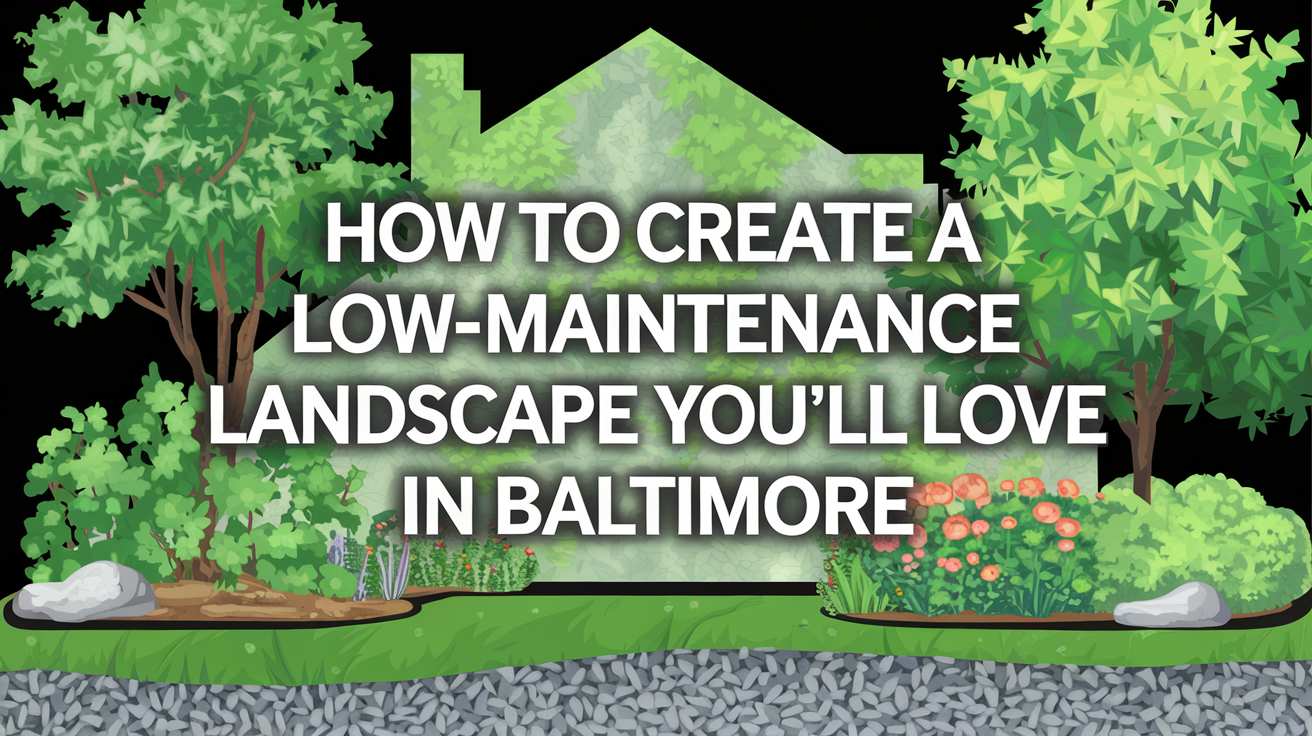Creating a beautiful and inviting outdoor space doesn’t have to mean endless hours of maintenance and upkeep. By implementing smart landscaping strategies and choosing the right plants and features, you can enjoy a stunning, low-maintenance landscape that perfectly suits your Baltimore home. In this article, we’ll share five essential tips to help you create a low-maintenance landscape you’ll love, while considering the unique climate and growing conditions of Baltimore.

Tip 1: Plant Selection
One of the most important aspects of creating a low-maintenance landscape is choosing the right plants. Opt for native and drought-resistant species that are well-adapted to Baltimore’s climate and soil conditions. These plants require less water, fertilizer, and pest control, making them easier to care for in the long run. Some excellent low-maintenance plant options for Baltimore include:
- Black-eyed Susan (Rudbeckia fulgida)
- Purple Coneflower (Echinacea purpurea)
- Sedum (Sedum spp.)
- Creeping Phlox (Phlox subulata)
- Switchgrass (Panicum virgatum)
When selecting plants, be sure to consider their mature size, growth habits, and sunlight requirements to ensure they thrive in your landscape. Local nurseries and garden centers, such as Valley View Farms and Kingsdene Nurseries, can provide expert advice on the best low-maintenance plants for your Baltimore landscape.
Tip 2: Efficient Irrigation Systems
Proper watering is crucial for maintaining a healthy landscape, but it doesn’t have to be a time-consuming task. Installing an efficient irrigation system, such as drip irrigation or a smart sprinkler system, can help you save water, time, and money while keeping your plants thriving. Drip irrigation systems deliver water directly to the roots of your plants, reducing evaporation and runoff, while smart sprinkler systems adjust watering schedules based on weather conditions and soil moisture levels.
When installing an irrigation system, be sure to:
- Plan your layout carefully to ensure even coverage
- Use high-quality components to prevent leaks and clogs
- Consider hiring a professional for complex installations
Local irrigation providers, such as Baltimore Irrigation and Aqua-Bright Irrigation, can help you design and install an efficient system tailored to your landscape’s needs.
Tip 3: Mulching
Mulching is a simple and effective way to reduce maintenance in your landscape. A layer of mulch helps suppress weed growth, retain soil moisture, and regulate soil temperature, all while giving your beds a polished look. Organic mulches, such as shredded bark or wood chips, also break down over time, adding valuable nutrients to your soil.
To properly apply mulch:
- Remove any existing weeds and debris
- Apply a 2-3 inch layer of mulch, keeping it away from plant stems and tree trunks
- Refresh the mulch annually or as needed
To save money on mulch, consider purchasing it in bulk from local suppliers or using recycled materials, such as leaves or grass clippings, in your beds.
Tip 4: Lawn Alternatives
While a lush, green lawn is a staple of many landscapes, it can also be one of the most time-consuming and resource-intensive features to maintain. Consider reducing your lawn area by incorporating lawn alternatives, such as:
- Ground covers like Ajuga, Creeping Thyme, or Pachysandra
- Artificial turf for high-traffic or hard-to-maintain areas
- Naturalized meadows or prairie plantings
These alternatives require less mowing, watering, and fertilizing than traditional turf grass, giving you more time to enjoy your outdoor space. When selecting lawn alternatives, consider their growth habits, sunlight requirements, and foot traffic tolerance to ensure they perform well in your landscape.
Tip 5: Hardscaping Features
Incorporating hardscaping features, such as paths, patios, and retaining walls, can not only enhance the beauty and function of your low-maintenance landscaping but also reduce the amount of plant material you need to maintain. Choose low-maintenance materials, such as concrete, pavers, or natural stone, that are durable and easy to clean.
When designing your hardscaping features:
- Consider your outdoor living needs and style preferences
- Ensure proper drainage to prevent water damage
- Choose materials that complement your home’s architecture and existing landscape
Look for inspiration in local gardens, home improvement shows, and online resources to help you create a cohesive and inviting hardscape design.
Conclusion
Creating a low-maintenance landscape in Baltimore is all about making smart choices in plant selection, irrigation, mulching, lawn alternatives, and hardscaping. By following these five tips, you can enjoy a beautiful, functional, and easy-to-maintain outdoor space that enhances your home’s curb appeal and provides a relaxing retreat for years to come. Remember to consult with local landscaping professionals and garden centers for personalized advice and assistance in bringing your low-maintenance landscape vision to life.

